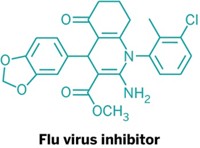Advertisement
Grab your lab coat. Let's get started
Welcome!
Welcome!
Create an account below to get 6 C&EN articles per month, receive newsletters and more - all free.
It seems this is your first time logging in online. Please enter the following information to continue.
As an ACS member you automatically get access to this site. All we need is few more details to create your reading experience.
Not you? Sign in with a different account.
Not you? Sign in with a different account.
ERROR 1
ERROR 1
ERROR 2
ERROR 2
ERROR 2
ERROR 2
ERROR 2
Password and Confirm password must match.
If you have an ACS member number, please enter it here so we can link this account to your membership. (optional)
ERROR 2
ACS values your privacy. By submitting your information, you are gaining access to C&EN and subscribing to our weekly newsletter. We use the information you provide to make your reading experience better, and we will never sell your data to third party members.
Biological Chemistry
Beating Back Bacterial Meningitis
Chemical heterogeneity could be used to tune forces in molecular recognition or self-assembly
by Sarah Everts
January 19, 2015
| A version of this story appeared in
Volume 93, Issue 3
A promising quartet of sugars on the external lipopolysaccharide of Neisseria meningitidis B, which causes as many as 80,000 bacterial meningitis cases worldwide every year, could form the basis of a new vaccine (Chem. Biol. 2015, DOI: 10.1016/j.chembiol.2014.11.016). Training the human immune system to fight bacterial meningitis is an ideal way to sidestep the disease’s consequences, which include hearing loss, brain damage, and death, especially in infants and children. But the development of an all-encompassing vaccine has been stymied by many challenges, including the fact that the disease is caused by several different pathogens. Furthermore, one of the causative agents, N. meningitidis, has several subtypes and current vaccines don’t work on all of them. A team of researchers led by Chakkumkal Anish and Peter H. Seeberger of the Max Planck Institute of Colloids & Interfaces, in Potsdam, Germany, therefore went looking on the lipopolysaccharide exterior of N. meningitidis for oligosaccharides that were common to all the subtypes. They synthesized a four-sugar component of this lipopolysaccharide and showed that it can raise broadly protective antibodies against the pathogen.





Join the conversation
Contact the reporter
Submit a Letter to the Editor for publication
Engage with us on Twitter